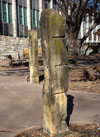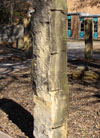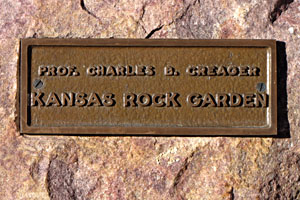
| Delivery of glacial boulders from Marshall County, northeastern Kansas. Dick Weatherholt supervises unloading the largest boulder (1988).
|  |

| Building the foundation and native-limestone wall that forms the back of the rock garden (1991).
|  |

| Pouring concrete for sidewalks of the rock garden. The concrete is tinted adobe-red color, as is the mortar in the limestone wall (1992).
|  |

| Overviews of the completed rock garden. Left: early spring seen from the northeast. Right: summer view from the southeast.
|  |

| Partial solar eclipse in May 1994. Left: students and faculty prepare to view the partial solar eclipse. Right: crescentic highlights and shadows cast through tree leaves onto the sidewalk.
|  |

| Science Hall got a facelift in 2012. The original teal panels and aluminum-shuttered windows were replaced by smoked-glass panels and new windows. These pictures show construction work in progress behind the rock garden.
| 
|

| Glacial erratics. Left: granite boulder with lichen cover (green spots). Right: Boulder of greenstone; red pocket knife rests on a flat, glacially planed surface. Both were carried by an ice sheet from the Canadian Shield of northern Minnesota or Manitoba and deposited in Marshall County, northeastern Kansas.
|  |

| Sioux Quartzite. Left: quartzite conglomerate boulder collected from Wabaunsee County, northeastern Kansas. It was carried by an ice sheet from southwestern Minnesota or southeastern South Dakota. Right: glacial scratches and grooves on quartzite from Red Rock Ridge, southern Minnesota.
|  |

| The largest single glacial boulder (left) consists of green matrix with large quartz crystals (right), a type of volcanic rock. This specimen was collected in Marshall County, northeastern Kansas. It was carried by an ice sheet from northern Minnesota or Canada; comb is 5 inches long.
|  |

Stone fence posts are an iconic symbol in the Blue Hills of west-central Kansas. They were quarried from the Fence-post limestone bed of the Greenhorn Limestone (upper Cretaceous) by early settlers. Tool marks remain clearly visible in the chalky limestone. Donated by Paul Johnston from Barton County.
| 

| Petrified wood: tree stump and portion of trunk from the Flint Hills of Greenwood County, east-central Kansas. This remarkable fossil tree is early Permian in age. Collected by Paul Johnston.
|  |

| Left: large nodules of chert (flint) from lower Permian strata of the Flint Hills, Butler County, south-central Kansas. Right: fossil coral from the Clay Creek Member, upper Pennsylvanian strata, Woodson County, southeastern Kansas.
| 
| | |



 Return to Geospectra academic webpages.
Return to Geospectra academic webpages.